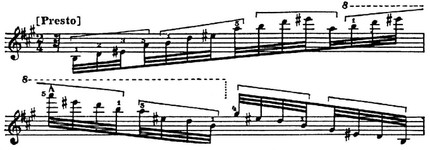
Position |
from lat. positio —position
The position of the performer’s hand and fingers when playing a musical instrument in relation to the fretboard of a stringed instrument or the keyboard of a keyboard instrument.
1) When playing the violin P. – the position of the left hand on the fretboard, which is determined by the ratio and interaction of the first and thumb and allows you to perform a given sequence of sounds without moving your hand. P.’s location is determined by the distance from the first finger placed on the string to the nut. 1st P. is called such a position of the hand and first finger in relation to the nut, with Krom on the string e, the sound f1 is extracted. The fretboard of a violin is usually divided into P., depending on the change in the distance between the first finger and the nut and the corresponding change in the position of the thumb when the hand is successively moved up along the neck. In 1738 the Frenchman M. Corret in his “School of Orpheus” introduced the division of the violin neck into 7 positions. He based this division on the distinction of the fretboard in tones and semitones; each P. on one string embraces the range of a quart.
This division, to-rogo adhered to the representatives of the French. violin school, subsequently became generally accepted (with the development of virtuoso technique, the number of violin increased. The division of the neck of the violin into P.

is a rational auxiliary tool, a cut in the process of initial training helps the student to master the neck. The notion of P. allows the violinist to mentally distribute the movements of the fingers over the corresponding sections of the fretboard and contributes to the development of a sense of distance. For those who have acquired technical the skills of a violinist, the belonging of sounds to one or another P. no longer has creatures. values and sometimes turns into a brake, fettering freedom of orientation on the fretboard. Actual the position of the violinist’s left hand in the process of performance is often in conflict with the generally accepted ordinal designation P. This introduces unnecessary confusion and is a source of serious errors when choosing a fingering.
In modern The practice of playing the violin is used diff. types of arrangement of fingers on the fretboard, enharmonic. replacement of sounds, simultaneous playing in adjacent P.
In such cases, it may be impossible to determine which position the hand is in from the point of view of the generally accepted positional system. Proceeding from this, P. should be considered only as a temporary starting point of support for finger movements, changing each time in accordance with the requirements of a specific musical-performing plan.
2) In the game on the fp. P. – a group of notes covered (or can be covered) on the keyboard by one position of the hand so that each finger at this time remains over the same key. The passage can be divided into P. performed by “complex” (as in chords) permutations of the whole hand (without inserting the 1st finger).

F. List. “Mephisto Waltz” (right hand part).
Such a performance of passages is one of the main principles of technology F. List, F. Busoni and their followers.
References: Yampolsky I., Fundamentals of violin fingering, M., 1933, revised. and additional ed., 1955 (ch. 5. Position); Logan G., On piano texture, M., 1961.
I. M. Yampolsky, G. M. Kogan



